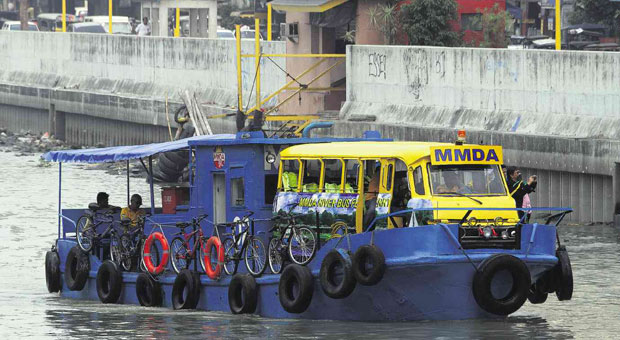
BUS FERRY DRY RUN The Metropolitan Manila Development Authority conducts a dry run of its ferry service on the Pasig River from Guadalupe, Makati City, to Intramuros, Manila, on Wednesday. The trip took one hour and 30 minutes. Reviving the ferry service is aimed at providing commuters a faster mode of travel in the metropolis. NIÑO JESUS ORBETA
Not much to look at, but it can save the day for some commuters and, more importantly, make an old idea worth another try.
Indicating its seriousness to revive the Pasig River ferry service, the Metropolitan Manila Development Authority on Wednesday conducted a test run of its improvised “river bus” as an alternative mode of transport in the metropolis, hoping to attract both riders and investors.
As the craft—a tugboat fitted with the body and seats of a mini-bus—made its way down the river, MMDA Chair Francis Tolentino said at least three companies had expressed their interest to the reopen the ferry service, a venture tried three times with government prodding in the past decades, with the last private operator shutting down in 2011.
During the trial run, the 40-seater vessel moved at a mere 5 knots and took one and a half hours to get from Guadalupe, Makati City, to Intramuros, Manila, slower than the last craft used which covered the same distance in 40 to 45 minutes.
But Tolentino, who invited reporters and media crews onboard, explained that this was because the MMDA craft was “overloaded” for the day’s trip.
Amy Gamay, information officer of the Pasig River Rehabilitation Commission, expressed confidence that road commuters would be encouraged to make the shift to river buses since “Pasig River is much cleaner now.”
“The bad smell of the river is gone. It is no longer that strong compared to the previous years,” said Gamay, who represented PRRC in the test run.
The MMDA has converted three 20-meter-long tugboats, usually used for rescue operations, to serve as ferries. Tolentino said they would start taking passengers in April from four stations: Guadalupe, Sta. Ana, Sta. Mesa, and Intramuros.
The fare would be decided in a meeting today, although Tolentino said there were proposals to peg it at P20 to P25, much lower than the P65 charged by the last operator.
“There are at least three companies who want to operate the ferries,” Tolentino said, adding that the MMDA service would give way once the private sector steps in. He declined to identify the companies, but said one of them was already involved in the past operations.
“We are going to discuss this, among other things, with the Department of Transportation and Communications and PRRC,” he said. “We need to rehabilitate first at least four stations and dredge the shallow portions of the river.”
By June, all 14 stations along the 25-kilometer waterway should be fully operational, he said.
The MMDA pushed for the revival of the ferry system as it warned of massive traffic jams in Metro Manila with the construction of 15 major infrastructure projects in the next two years.
Before its closure, the last ferry operation moved some 500,000 passengers a year from 2007 to 2010, according to the MMDA. “That’s the number of people who would no longer cram themselves into the trains and major roads (once the ferries are back),” Tolentino said.
Citing the lessons of past operators, Tolentino suggested that the vessels be smaller and easier to fill up so there would be a shorter waiting time at the stations and higher income for the operators.
RELATED STORIES
MMDA holds dry run on Pasig River ferry service
Gov’t urged to revive Pasig ferry service

